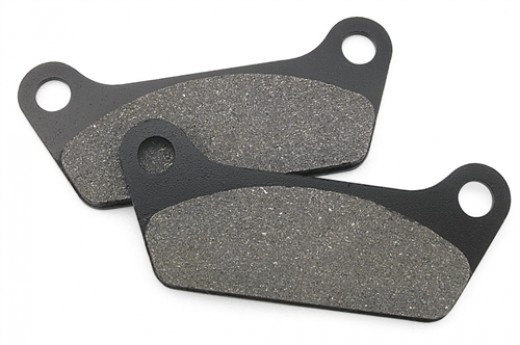Brake pads
Collapse
X
-
I found what appears to be copper metal in my brake pads, are those copper sintered pads? They state they were made in the UK and carry designations of FA70 and DMX, also the number K045,
I put ceramic pads, which are hard, on my vette and they didnt stop well until they got hot and ate my rotors.
My understanding is that if these ones I have are copper sintered, they are not that bad on rotors. 82 XJ 1100
82 XJ 1100
98 Magna
past bikes
ST1100
92 Harley FXR built
85 XJ 700 (2)
86 XJ 700XComment
-
this is from:
 All motorcycle brake pads are designed for one purpose; stop the bike. The concept is fairly simple and relies on the generation of friction. Friction is produced by forcing the brake pads against a rotor. When enough friction is created, the...
All motorcycle brake pads are designed for one purpose; stop the bike. The concept is fairly simple and relies on the generation of friction. Friction is produced by forcing the brake pads against a rotor. When enough friction is created, the...
"Organic and Non-Metallic Brake Pads
Non-metallic and organic brake pads are usually comprised of a mixture of carbon, Kevlar, and a binding resin. Though Asbestos has been used in the past, Kevlar has replaced Asbestos because of the health concerns surrounding it. Organic and non-metallic brake pads produce less rotor wear than metallic compounds, making them metter for chromed rotors. The trade-off is in heat dissipation. Since non-metallic and organic brake pads do not dissipate heat as well as other compounds, they are more susceptible to brake "fade." Fade describes the reduction of stopping power as the pads heat up. Organic brake pads should only be used in systems specifically designed for them."
"Semi-Metallic Brake Pads
Semi-metallic brake pads (also known as metallic brake pads) are typically made of brass, copper or steel wool shavings and a binding resin. Semi-metallic brake pads dissipate heat better, thereby reducing fade, but their higher metal content produce higher rotor wear. They tend to create more brake dust and tend to be noisier than organic and ceramic counterparts."
"Ceramic Brake Pads
Ceramic Brake Pads use a combination of copper strands, ceramic materials, and a binding resin. This combination of materials produces less rotor wear compared to those with steel compounds. Ceramic brake pads also have the characteristcs of superior heat dissipation and durability. noise and brake dust are reduced because of their construction. Though typically more expensive, differences in relative cost are decreasing because of increasing popularity."

Of course, this says nothing of the characteristics of the rotors on our bikes, and whether they are right for use with a particular pad. It is interesting though that they say the ceramic pads create less wear.
I have been using ceramic pads with on my car for a couple of years now with no problems at all and very little wear.Last edited by Guy_b_g; 05-24-2010, 09:44 PM.Guy
'78E
Quidquid latine dictum sit, altum videtur
Comment
-
The rotors on our bikes are some of teh hardest I have seen, they wear like iron, cant be cut/turned. My last set was 10+ years ago, but I've always used semi-metallic scintered(sp) pads, have over 120K on my 79, rotors look new.2005 FJR 1300 "Mission" (NON ABS)
1979 XS 1100 SF "Visitation" Owned since 1984 - SS Brake Lines, TKAT fork brace, Progressive Fork Springs.
1978 XS 750 D "Motivation" - 9" rear custom shocks, dropped front end, shaved seat
When Caged:2006 Jeep Commander, 1986 Cutlass 442, 1976 Porsche 912E (latest project)Comment
Comment